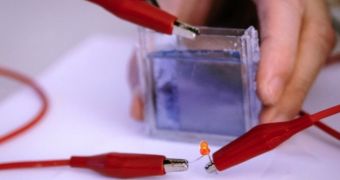Car windows can be clear or tinted, and some don't even bother with special glass and use very thin tinting foil instead. On the other end of the spectrum, however, are the really advanced types of windows, like the one that scientists from the Nanyang Technological University (NTU) have just come up with.
This is one research breakthrough that we'd like to see put into practice as soon as possible. It combines practicality with aesthetic value in equal doses. One might even say that the two come together in a whole that is more than the sum of its parts.
The new window is based on a new self-tinting window technology. One that differs from all other such technologies by virtue of not needing power at all.
Indeed, one could say the situation has been reversed, as it is, they can gather up energy and supply it to other systems and objects.
The self-tinting window from NTU
The new windows stay totally clear during the night but turn a mild shade of blue during the day, thus cutting light penetration by half and making it easier to weather the long hours of a car drive.
The change happens automatically, instead of you needing to activate a darkening chemical process by means of an application of power.
Moreover, the windows gather power during the day, enough to supply various auxiliary systems in the car with more or less free energy.
There should be enough power gathered during a day or two to recharge your phone and maybe even restore the charge of your car battery back to full given enough time.
For an electrochromic window, the technology sure is versatile. Bi-functional, project leading Prof Sun Xiaowei dubbed it.
Notably enough, the window turns blue and charges up when there is oxygen in the electrolyte, meaning the window practically breathes.
For those who want details, the liquid electrolyte is literally placed in between two glass sheets that are coated with indium tin oxide (ITO), commonly used as transparent conductive coatings for TV displays.
One of the sheets is coated with Prussian Blue pigment, while the other is attached to a thin aluminum foil strip. Typical electric cables link the glass sheets. The chemical reaction starts when the circuit between them is broken, causing glass to turn blue (the chemical reaction starts between the pigment and the dissolved oxygen in the electrolyte).
Practical applications and availability
The bi-functional smart electrochromic window invented by scientists from the Nanyang Technological University, otherwise described as a transparent battery, isn't available yet, and needs to be refined before deployment in vehicles. It shouldn't take too many months or years for the final step to be made though.

 14 DAY TRIAL //
14 DAY TRIAL //